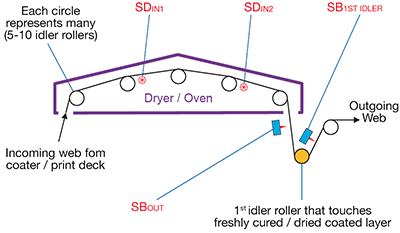Static Beat | Control Static on Insulating Webs in Dryers
- Published: July 23, 2015, By Dr. Kelly Robinson
How to protect solvent dryers/ovens from sparks caused by static on insulating webs.
Sparks are bad. Static sparks can release enough electrical energy to ignite flammable solvent vapors in solvent dryers and ovens. Following coaters or print decks, dryers or ovens remove the liquid in coating solution or ink. Once the liquid is removed, a coated layer remains on the web exiting the dryer or oven.
Normally, the solvent concentration in ovens and dryers is well below the Lower Explosive Limit (LEL) or the Lower Flammability Limit (LFL). So, static sparks cannot ignite the vapors. However, there are at least three ways that enough solvent vapors can accumulate in dryers or ovens so that static sparks can ignite fires.
- Air handler (fan) failure—If a dryer fan throws a belt, air flow may be greatly reduced in a dryer section. Solvent vapors accumulate rapidly when dryer air is stagnate.
- Web folds or creases—These can carry an unusually large amount of solvent into the dryer. We work hard to eliminate folds and creases entering coaters or print decks because they cause customer observable defects and waste. In gravure coaters and roll coaters, where the web is exposed to substantial amounts of coating solution, a crease or fold can trap coating solution and carry an unusually large amount of solution from the coater into the dryer. The extra solution can increase the solvent concentration near the dryer entry resulting in a flammable atmosphere.
- Air recirculation or “dead zones”—Dryers and ovens are designed so that air flows across the coated web surface, evaporating the liquid, and moving the vapor laden air away from the web. However, if there are areas where air flows circulate or forms vortices, solvent vapors can accumulate instead of being exhausted from the dryer. The accumulation of vapors can result in a flammable concentration.
Sparks should be suppressed in solvent dryers and ovens to prevent fires. With good static control upstream, a charge-free web enters the dryer in Figure 1. However, when the web touches idler rollers in the dryer, the back, uncoated web surface becomes charged. After touching many idler rollers, enough charge accumulates to cause sparks. So, after 10–20 idler rollers, install passive static dissipators to keep the charge levels low.

For example, static dissipator SDIN1 in Figure 1 is installed in the solvent dryer to dissipate static on the uncoated web surface from the first 10–20 idlers. And, SDIN2 dissipates static from rollers between SDIN1 and SDIN2. Of course, the static dissipators installed inside dryers or ovens must be designed to function at the operating temperatures. For high temperatures, you may need to use tinsel or needle bars having only metal components.
The uncoated surfaces of webs exiting dryers can carry high levels of static that pose threats to downstream operations. The best practice is to dissipate static on web exiting dryers before the web reaches the first roller that touches the freshly dried coated layer. The first roller that touches the freshly dried or cured layer is a critical roller because this fresh surface may be very triboelectrically active. And, once static charges are present on both surfaces of the web, neutralizing static effectively is problematic.
Active static bar SBOUT in Figure 1 is installed to dissipate static on the uncoated surface of the web exiting the drier.
The first roller that touches a freshly dried or cured layer is a critical roller. The freshly formed coating is often very active from a triboelectric charging perspective. And, the web exiting this roller can have very large amounts of static on the coated surface. Active static bar SB1ST IDLER in Figure 1 is installed to dissipate static on the freshly formed coating on the web span exiting the first roller that touches the coating.
Sparks are bad. Sparks can release enough electrical energy to ignite flammable solvent vapors. To prevent static fires in solvent dryers and ovens, we must suppress sparks. The uncoated surface of an insulating web accumulates static charges by touching the idler rollers inside the dryer or oven.
I invite you to ask questions about this column and to suggest future topics. My email address is: Kelly.Robinson@ElectrostaticAnswers.com.
Static control expert Dr. Kelly Robinson, president of Electrostatic Answers, has 27+ years of experience in problem-solving and consulting. Kelly writes PFFC's Static Beat column and the Kelly on Static blog. Contact him at 585-425-8158; kelly.robinson@electrostaticanswers.com; www.electrostaticanswers.com.












